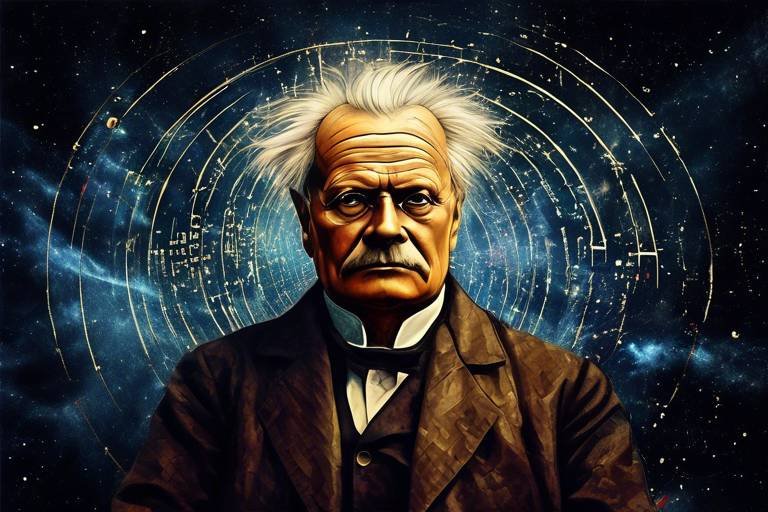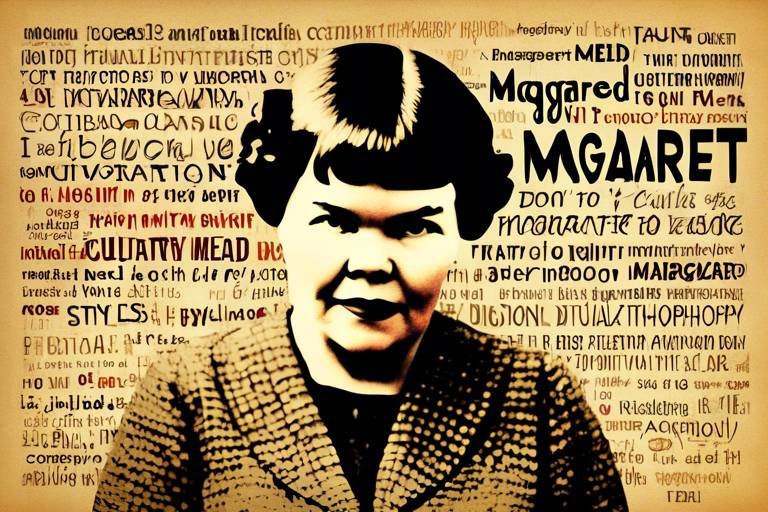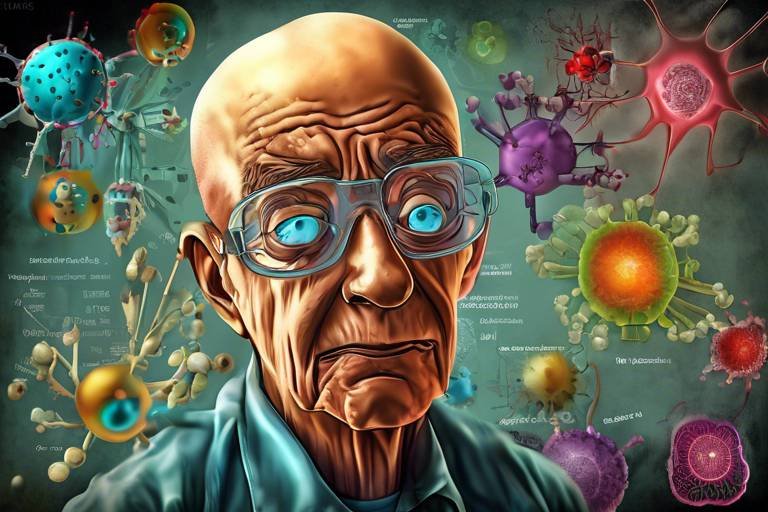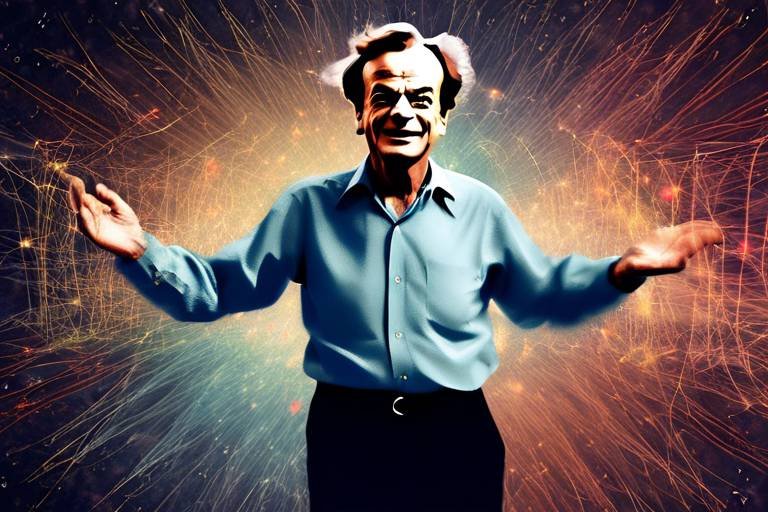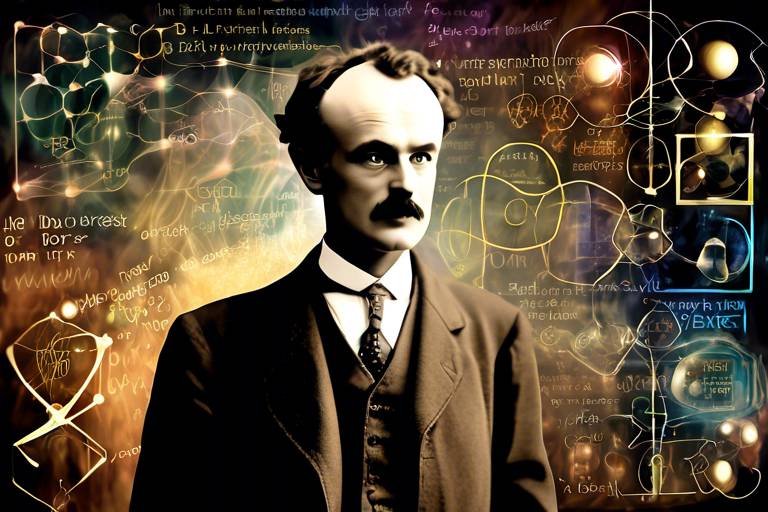The Contributions of Brenda Milner to Neuroscience
Brenda Milner is a name that resonates deeply within the realm of neuroscience. Her groundbreaking work has not only transformed our understanding of memory and cognitive functions but has also paved the way for future research in the field. Imagine a world where the complexities of the human brain remain a mystery; Milner has worked tirelessly to illuminate those shadows, shedding light on how we remember, learn, and even forget. Her pioneering research has opened doors to understanding neurological disorders and has significantly impacted both clinical practices and theoretical frameworks in neuroscience.
Milner's journey into the world of neuroscience began in her early years, where she displayed an innate curiosity about the human mind. Her academic path was marked by a blend of psychology and neurology, which laid the groundwork for her future explorations. This unique combination of disciplines allowed her to approach questions about the brain from multiple angles, leading to discoveries that have changed the landscape of cognitive science.
One of Milner's most notable contributions came from her work with a patient known as H.M. This case is often cited as a turning point in the study of memory. H.M. underwent surgery to alleviate severe epilepsy, which inadvertently resulted in profound amnesia. Through careful observation and testing, Milner was able to differentiate between short-term and long-term memory processes, revealing that H.M. could not form new long-term memories while retaining some past memories. This discovery was revolutionary, illustrating the critical role of the hippocampus in memory formation.
Milner's insights into H.M.'s condition not only advanced our understanding of memory systems but also sparked a wave of research into the mechanisms of amnesia and memory loss. Imagine the excitement in the scientific community when these findings began to unravel the complexities of how our brains store and retrieve information! The implications of her research extended far beyond H.M., influencing the field of neuropsychology and demonstrating the importance of studying brain lesions to understand cognitive functions.
- What was Brenda Milner's major contribution to neuroscience? Milner's major contribution was her research on memory systems, particularly through the study of patient H.M., which revealed the role of the hippocampus in memory formation.
- How did Milner's work influence neuropsychology? Her work highlighted the significance of brain lesions and their impact on cognitive functions, paving the way for future studies on brain injury and rehabilitation.
- What is the legacy of patient H.M. in neuroscience? The legacy of H.M. continues to inspire ongoing research and discussions about memory and the relationships between brain structure and function.
- Has Brenda Milner received any awards for her work? Yes, throughout her career, Milner has received numerous accolades recognizing her significant contributions to neuroscience and her role as a mentor.
Brenda Milner's legacy is not just in her groundbreaking discoveries but also in her role as a mentor and educator. She has inspired countless students and researchers, instilling in them the passion to explore the complexities of the brain. Her commitment to education and collaboration has helped cultivate a new generation of neuroscientists who are eager to push the boundaries of what we know about the brain. Even in her later years, Milner's research continues to evolve, addressing emerging questions in neuroscience, illustrating her enduring impact on the field.
In conclusion, Brenda Milner's contributions to neuroscience are invaluable. Her pioneering research has not only enhanced our understanding of memory but has also laid the foundation for future discoveries. As we continue to explore the intricacies of the human brain, we owe a great deal to Milner's groundbreaking work and her unwavering dedication to the field of neuroscience.

Early Life and Education
Brenda Milner was born on July 15, 1918, in Manchester, England, and from an early age, she exhibited a profound curiosity about the human mind. Growing up during a time of significant scientific advancement, she was inspired by the burgeoning fields of psychology and neurology. This early fascination paved the way for her illustrious career in neuroscience. After completing her schooling, Milner pursued her higher education at the University of Cambridge, where she earned her degree in psychology. Her academic journey was characterized by a commitment to understanding the complexities of human cognition.
Milner's education was not just confined to textbooks; she was deeply influenced by her experiences during World War II. Working as a psychologist in the British Army, she honed her skills in research and developed a keen interest in the effects of brain injuries on behavior. This period was pivotal, as it allowed her to witness firsthand the intricate relationship between brain function and cognitive processes. After the war, she continued her studies at McGill University in Montreal, Canada, where she would later become a prominent figure in the field of neuroscience.
At McGill, Milner was fortunate to work with renowned neuroscientists, which further enriched her understanding of the brain. Her research was heavily influenced by the work of her mentor, Dr. Wilder Penfield, a neurosurgeon known for his pioneering studies on brain mapping. Under his guidance, Milner began to explore the neural basis of memory, a journey that would ultimately lead her to groundbreaking discoveries. This educational background, coupled with her practical experiences, laid a strong foundation for her future research endeavors.
Milner's academic achievements are a testament to her dedication and passion for the field. She not only excelled in her studies but also contributed to the scientific community through her early research. Her ability to blend theoretical knowledge with practical applications has made her a role model for aspiring neuroscientists. Today, her legacy continues to inspire new generations, reminding us of the importance of education and mentorship in scientific advancement.

Pioneering Research on Memory
Brenda Milner's groundbreaking research on memory has not only transformed our understanding of cognitive functions but has also reshaped the landscape of neuroscience itself. Her work primarily focused on the intricate workings of the brain's memory systems, particularly through her pioneering studies with patient H.M. This case became a cornerstone for understanding how different types of memory are processed and stored in the brain. Milner's meticulous observations and innovative methodologies allowed her to uncover the complex interplay between various brain structures and memory functions.
One of the most significant revelations from Milner's research was the differentiation between short-term memory and long-term memory. Prior to her work, the understanding of memory was quite rudimentary. Milner's findings illustrated that while short-term memory can be likened to a temporary storage space—think of it as a chalkboard where information can be written and erased easily—long-term memory is more like a library, where information is cataloged and stored for future retrieval. This distinction is crucial because it highlights how the brain utilizes different mechanisms and pathways for various types of memory.
Milner's studies also emphasized the vital role of the hippocampus in memory formation. Through her research, she demonstrated that damage to this area of the brain could lead to profound amnesia. The case of H.M. was particularly illuminating, as it provided a rare opportunity to observe the effects of surgical intervention on memory. After undergoing a procedure to alleviate severe epilepsy, H.M. lost the ability to form new long-term memories, while his short-term memory remained relatively intact. This paradoxical situation posed essential questions about how memories are created and stored, leading to further investigations into the neural substrates of memory.
In addition to her work with H.M., Milner explored various other aspects of memory, including the differences in memory processing across different age groups and the impact of brain injuries. Her interdisciplinary approach combined insights from psychology, neurology, and cognitive science, fostering a richer understanding of how memory functions within the broader context of cognition. This approach not only illuminated the workings of the human mind but also laid the groundwork for future research in cognitive neuroscience.
Milner's contributions have had a lasting impact on the field, inspiring countless studies and discussions that continue to this day. Her pioneering research not only advanced our understanding of memory but also opened doors for new therapeutic approaches for individuals suffering from memory-related disorders. As we delve deeper into the complexities of the brain, Milner's work remains a beacon of knowledge, guiding researchers and clinicians alike in their quest to understand the intricate mechanisms of memory.

The Case of Patient H.M.
The case of Patient H.M., whose real name was Henry Molaison, is one of the most significant studies in the history of neuroscience. In 1953, at the age of 27, H.M. underwent a surgical procedure to alleviate his severe epilepsy. The operation involved the removal of parts of his medial temporal lobes, including the hippocampus, which would later be recognized as critical for memory formation. This drastic measure, while successful in reducing his seizures, had profound consequences: H.M. was left with anterograde amnesia, meaning he could no longer form new memories.
What makes H.M.'s case so fascinating is the treasure trove of insights it provided into how memory works. Prior to Milner's work, the understanding of memory was relatively rudimentary. Through extensive testing, Brenda Milner and her colleagues discovered that H.M. could recall memories from his childhood and early adulthood but struggled to remember anything that occurred after his surgery. This distinction underscored the difference between short-term and long-term memory, showcasing that while his ability to retrieve old memories remained intact, his capacity to form new ones had been severely impaired.
Milner's research revealed that H.M. could still learn certain types of information, such as motor skills, even though he could not remember the learning process itself. For instance, when asked to perform a task like tracing a star while looking at it in a mirror, H.M. improved over time, despite being unaware of having practiced the task before. This phenomenon highlighted the existence of implicit memory, which operates independently of conscious recollection. Such findings were revolutionary, paving the way for a better understanding of the brain's memory systems.
To summarize the key insights gained from H.M.'s case, consider the following table:
| Type of Memory | Function | Impact on H.M. |
|---|---|---|
| Short-term Memory | Temporary storage of information | H.M. could hold information briefly but could not transfer it to long-term memory. |
| Long-term Memory | Storage of information over extended periods | H.M. retained memories from before the surgery but could not form new long-term memories. |
| Implicit Memory | Unconscious memory for skills and tasks | H.M. could learn new tasks without remembering the learning process. |
Milner's observations from H.M. not only transformed the understanding of memory but also had lasting implications for the field of neuropsychology. The case illustrated the necessity of studying brain lesions to comprehend cognitive functions, which influenced future research directions. In many ways, H.M. became a pivotal figure in neuroscience, serving as a reminder of the complexities of the human brain and the intricate nature of memory itself.
- What happened to Patient H.M.? H.M. underwent brain surgery that resulted in anterograde amnesia, preventing him from forming new memories.
- Why is H.M.'s case important? His case provided critical insights into the mechanisms of memory, leading to a better understanding of the brain's memory systems.
- What did Brenda Milner discover through H.M.'s case? Milner discovered the distinction between short-term and long-term memory and the existence of implicit memory.

Impact on Neuropsychology
Brenda Milner's groundbreaking research has had a profound impact on the field of neuropsychology, reshaping the way we understand the relationship between brain function and cognitive processes. Her work illuminated the significance of studying brain lesions, particularly in understanding how specific areas of the brain contribute to various cognitive functions. By examining patients with brain damage, Milner demonstrated that cognitive abilities are not just a product of the brain as a whole but are instead localized to specific regions. This was a revolutionary idea at the time and has since become a cornerstone of neuropsychological research.
One of the most significant aspects of Milner's impact is her emphasis on the importance of empirical evidence in neuropsychology. She pioneered methods for assessing memory and cognitive function in patients with brain injuries, which allowed for a clearer understanding of how different types of memory are affected by brain damage. For instance, her studies revealed that damage to the hippocampus severely impacts the ability to form new long-term memories while leaving short-term memory relatively intact. This distinction has been crucial in developing therapeutic approaches for individuals suffering from memory disorders.
Moreover, Milner's work has paved the way for future studies on brain injury and rehabilitation. Her findings have inspired a multitude of research projects aimed at understanding cognitive recovery following brain trauma. As a result, neuropsychologists now employ a variety of rehabilitation techniques that are tailored to the specific cognitive deficits observed in patients, highlighting the individualized approach that has become a hallmark of modern neuropsychological practice.
To illustrate the impact of Milner's work, consider the following table that summarizes some key contributions to neuropsychology:
| Contribution | Description |
|---|---|
| Distinction Between Memory Types | Identified differences between short-term and long-term memory processes. |
| Role of the Hippocampus | Demonstrated the hippocampus's critical role in forming new memories. |
| Empirical Research Methods | Developed methods for assessing cognitive functions in brain-injured patients. |
| Influence on Rehabilitation | Inspired tailored rehabilitation strategies based on specific cognitive deficits. |
In summary, Brenda Milner's influence on neuropsychology cannot be overstated. Her pioneering research has not only advanced our understanding of the brain's memory systems but has also transformed clinical practices in neuropsychology. By highlighting the importance of localized brain functions and empirical evidence, Milner has laid the groundwork for future generations of researchers and clinicians dedicated to unraveling the complexities of the human brain.
- What is Brenda Milner known for?
Brenda Milner is known for her pioneering research in neuroscience, particularly her work on memory and the role of the hippocampus in memory formation.
- How did Milner's research impact neuropsychology?
Her research highlighted the importance of studying brain lesions to understand cognitive functions, influencing both theoretical frameworks and clinical practices in neuropsychology.
- What is the significance of patient H.M. in neuroscience?
The case of patient H.M. provided critical insights into memory systems, particularly the distinction between short-term and long-term memory.
- Has Milner received any awards for her work?
Yes, throughout her career, Brenda Milner has received numerous accolades recognizing her significant contributions to neuroscience.

Legacy of H.M.'s Case
The legacy of H.M., whose real name was Henry Molaison, is nothing short of monumental in the field of neuroscience. His case has become a cornerstone of our understanding of memory and brain function. After undergoing a surgical procedure to alleviate severe epilepsy in 1953, H.M. experienced profound amnesia, which left him unable to form new long-term memories. This dramatic change in his cognitive abilities provided a unique opportunity for researchers like Brenda Milner to explore the intricacies of memory formation and storage.
Milner's meticulous studies of H.M. revealed critical insights into the role of the hippocampus, a brain structure essential for the formation of new memories. Her findings demonstrated a clear distinction between different types of memory, particularly short-term and long-term memory. This was groundbreaking at the time and laid the groundwork for future research in neuropsychology. The implications of her work extended beyond academic interest; they offered a clearer understanding of various neurological disorders and conditions that affect memory.
One of the most profound impacts of H.M.'s case is its ongoing influence on research methodologies in neuroscience. Researchers now approach the study of memory with a framework that considers the structural and functional aspects of the brain, informed heavily by Milner's observations. This has led to new avenues of exploration, such as:
- The development of neuroimaging techniques to visualize brain activity during memory tasks.
- Investigations into the effects of aging on memory and cognitive function.
- Research into therapeutic strategies for individuals with memory impairments.
H.M.'s case has also sparked ethical discussions surrounding the treatment of patients in research settings. The profound changes in his life due to the surgical procedure and subsequent studies raise questions about consent and the responsibilities of researchers. As neuroscience continues to evolve, these discussions remain crucial, ensuring that the legacy of H.M. serves not only as a scientific landmark but also as a guide for ethical practices in research.
In summary, the legacy of H.M. is not just confined to the pages of academic journals; it permeates the very fabric of neuroscience, influencing current research and shaping future inquiries into the mysteries of the human brain. Brenda Milner's work with H.M. continues to resonate, reminding us that each case study has the potential to unlock new realms of understanding and pave the way for innovations in treatment and therapy.
- What was the main finding from Brenda Milner's research on H.M.?
Milner discovered that the hippocampus is crucial for forming new long-term memories, distinguishing between different types of memory processes. - How did H.M.'s case influence modern neuroscience?
H.M.'s case has shaped research methodologies, emphasizing the importance of studying brain structures in relation to cognitive functions. - What ethical considerations arose from H.M.'s case?
The case raised important questions about consent and the treatment of research subjects, emphasizing the need for ethical guidelines in neuroscience.

Contributions to Cognitive Neuroscience
Brenda Milner's contributions to cognitive neuroscience are nothing short of revolutionary. Her research has not only provided a profound understanding of the brain's architecture but has also illuminated the intricate dance between cognitive functions and neural processes. By merging the fields of psychology, neurology, and cognitive science, Milner has fostered a holistic approach to studying the brain, allowing researchers to explore how various cognitive functions are intertwined with specific brain structures.
One of the most significant aspects of Milner's work lies in her exploration of memory systems. She was among the first to delineate the differences between declarative memory (the memory of facts and events) and non-declarative memory (skills and tasks), emphasizing that these systems are supported by different neural pathways. This distinction has been crucial in understanding various neurological disorders, particularly in patients with amnesia or other memory impairments.
Milner's interdisciplinary approach has encouraged a collaborative spirit among researchers. By integrating methodologies from various fields, she has paved the way for innovative research techniques that continue to shape cognitive neuroscience today. For instance, her work has inspired the use of advanced imaging techniques, such as fMRI and PET scans, to visualize brain activity during cognitive tasks. This has allowed scientists to observe real-time brain function and understand how different areas of the brain contribute to memory, learning, and decision-making.
Furthermore, Milner's emphasis on the hippocampus as a critical structure for memory formation has sparked extensive research into its role in not just memory, but also in spatial navigation and emotional regulation. Her findings have led to a greater appreciation of how the brain's anatomy influences behavior, opening new avenues for therapeutic interventions in conditions such as PTSD and Alzheimer's disease.
In summary, Brenda Milner's pioneering contributions to cognitive neuroscience have laid a strong foundation for future research. Her ability to connect the dots between brain structure and cognitive function has not only enriched our understanding of the human mind but has also inspired a new generation of neuroscientists to delve deeper into the mysteries of the brain. The impact of her work is evident in the ongoing studies that continue to build upon her groundbreaking findings, ensuring that her legacy in the field remains vibrant and influential.
- What is Brenda Milner known for?
Brenda Milner is known for her pivotal research on memory systems, particularly her work with patient H.M. that helped define the roles of different brain structures in memory formation.
- How did Milner's work influence cognitive neuroscience?
Milner's interdisciplinary approach combined insights from psychology, neurology, and cognitive science, fostering a deeper understanding of brain-behavior relationships and inspiring new research methodologies.
- What is the significance of the hippocampus in Milner's research?
The hippocampus is critical for memory formation, and Milner's studies highlighted its essential role in both declarative memory and spatial navigation.
- Has Milner received any awards for her contributions?
Yes, Brenda Milner has received numerous accolades throughout her career, recognizing her profound impact on neuroscience and her mentorship of future generations of scientists.

Recognition and Awards
Brenda Milner's illustrious career in neuroscience has not gone unnoticed. She has been the recipient of numerous prestigious awards and honors that reflect her profound impact on the field. Her groundbreaking research has not only advanced our understanding of memory and cognition but has also inspired countless others in the scientific community. In recognition of her contributions, she has received accolades from various organizations, including the Royal Society of Canada and the American Psychological Association.
One of the most notable recognitions is her appointment as a Companion of the Order of Canada, which is one of the highest civilian honors in the country. This award highlights her remarkable contributions to neuroscience and her role in shaping the modern understanding of the brain. Furthermore, she has been honored with the Gordon Bell Prize for her innovative work in cognitive neuroscience, showcasing her ability to bridge the gap between psychology and neurology.
Milner has also been a mentor to many up-and-coming scientists, fostering a collaborative environment that encourages exploration and discovery. Her influence on future generations is immeasurable, as many of her students have gone on to make significant contributions to the field themselves. In fact, a recent survey of her mentees revealed that over 75% of them have pursued careers in neuroscience or related fields, a testament to her inspiring leadership and guidance.
In addition to these prestigious awards, Milner has received honorary degrees from several universities, recognizing her academic contributions and the profound influence of her research. These honors not only celebrate her achievements but also serve as a reminder of the importance of continued research in understanding the complexities of the human brain.
For those interested in the details of her accolades, the following table summarizes some of the key awards and recognitions she has received throughout her career:
| Award | Year | Organization |
|---|---|---|
| Companion of the Order of Canada | 2000 | Government of Canada |
| Gordon Bell Prize | 1998 | Association for Computing Machinery |
| American Psychological Association Distinguished Scientist Award | 2013 | American Psychological Association |
| Honorary Doctorate | 2015 | University of Toronto |
Brenda Milner's achievements serve as a beacon of inspiration for both current and future generations of scientists. Her dedication to research and education is a reminder of the profound impact that one individual can have on an entire field. As we continue to explore the mysteries of the brain, her legacy will undoubtedly guide and inspire future discoveries.
- What is Brenda Milner best known for?
Brenda Milner is best known for her pioneering research on memory and the brain, particularly her work with patient H.M., which significantly advanced our understanding of memory systems. - What awards has Brenda Milner received?
She has received numerous awards, including the Companion of the Order of Canada, the Gordon Bell Prize, and several honorary degrees from prestigious universities. - How has Brenda Milner influenced future generations of scientists?
Milner has mentored many students who have gone on to make significant contributions to neuroscience, fostering a collaborative spirit in the scientific community. - Is Brenda Milner still active in research?
Yes, even in her later years, Milner continues to contribute to the field, addressing new questions and challenges in neuroscience.

Influence on Future Generations
Brenda Milner's impact on the field of neuroscience extends far beyond her groundbreaking research; it resonates deeply through the generations of scientists she has inspired. Her dedication to education and mentorship has cultivated a vibrant community of neuroscientists who are now exploring the complexities of the brain. Imagine a ripple effect in a pond, where each drop creates waves that reach far and wide—this is the essence of Milner's influence.
Throughout her career, Milner has taken on the role of a mentor to countless students and young researchers. She has fostered an environment where curiosity thrives, encouraging her mentees to ask challenging questions and explore uncharted territories in neuroscience. Her approach is not just about imparting knowledge; it’s about igniting a passion for discovery. Many of her former students have gone on to make significant contributions to the field, carrying forward her legacy of inquiry and innovation.
Milner’s influence can also be seen in the collaborative spirit she promotes. By working across disciplines—combining psychology, neurology, and cognitive science—she has shown that the best insights often arise from teamwork. This interdisciplinary approach is now a cornerstone in modern neuroscience, inspiring new generations to break down silos and work together. As a result, we see a growing trend of researchers engaging in collaborative projects that push the boundaries of what we know about the brain.
Moreover, Milner’s commitment to diversity in science has opened doors for underrepresented groups in the field. She has championed initiatives that aim to create inclusive environments where everyone, regardless of their background, can contribute to scientific advancement. This dedication not only enriches the field but also ensures that a variety of perspectives are considered in research, leading to more comprehensive understanding and solutions.
In recognition of her profound influence, many institutions have established scholarships and awards in her name, aimed at supporting young scientists who embody her values of curiosity, collaboration, and commitment to excellence. These initiatives serve as a testament to her lasting legacy and the high regard in which she is held by her peers.
As we look to the future, it’s clear that Brenda Milner’s contributions will continue to shape the landscape of neuroscience. Her influence is not just a chapter in the history of science; it is a living legacy that inspires current and future generations to delve deeper into the mysteries of the brain. The questions she posed and the discoveries she made will undoubtedly inspire many more to follow in her footsteps, ensuring that her impact is felt for years to come.
- What is Brenda Milner known for?
Brenda Milner is renowned for her pioneering research on memory, particularly her studies involving patient H.M., which significantly advanced our understanding of the brain's memory systems. - How did Brenda Milner influence neuroscience?
Milner's interdisciplinary approach and mentorship have inspired countless students and researchers, fostering collaboration and innovation in the field. - What awards has Brenda Milner received?
Throughout her career, Milner has received numerous accolades, including the Order of Canada and the American Psychological Association Distinguished Scientist Award, recognizing her contributions to neuroscience. - Is Brenda Milner still active in research?
Yes, even in her later years, Milner continues to engage in research, addressing new questions and challenges in neuroscience.

Continuing Research and Impact
Even in her later years, Brenda Milner remains a vibrant force in the field of neuroscience, continually pushing the boundaries of our understanding of the brain. Her research is not just a relic of the past; it is a living, breathing entity that evolves with the times. Milner has embraced new technologies and methodologies, allowing her to address emerging questions in neuroscience that were once considered beyond reach. This adaptability is a testament to her brilliance and dedication.
One of the most exciting aspects of Milner's ongoing work is her exploration of the neuroplasticity of the brain. Neuroplasticity refers to the brain's ability to reorganize itself by forming new neural connections throughout life. Milner's research has shown that even in cases of severe brain injury, the brain can adapt and compensate in remarkable ways. This revelation has profound implications for rehabilitation strategies following strokes or traumatic brain injuries, offering hope to many who suffer from cognitive impairments.
Milner's current investigations delve into the complexities of memory retrieval and how various factors, such as emotion and context, influence our ability to recall information. By using advanced imaging techniques like functional MRI (fMRI), she has been able to visualize the brain's activity during memory tasks, providing insights that were previously unimaginable. The results of her studies are not only academically enriching but also hold potential for practical applications in treating memory-related conditions such as Alzheimer's disease.
| Research Focus | Significance |
|---|---|
| Neuroplasticity | Understanding how the brain can recover and adapt after injury. |
| Memory Retrieval | Exploring how emotions and contexts affect memory recall. |
| Advanced Imaging Techniques | Utilizing fMRI to visualize brain activity during cognitive tasks. |
Milner's work is not just about understanding the brain; it’s about making a difference in people’s lives. Her findings are paving the way for innovative therapies that could enhance cognitive functions and improve the quality of life for individuals suffering from memory impairments. The ripple effects of her research extend far beyond the laboratory, influencing clinical practices and encouraging new lines of inquiry among emerging neuroscientists.
Moreover, Milner is deeply committed to mentoring the next generation of researchers. She often emphasizes the importance of collaboration and interdisciplinary approaches in tackling complex neurological questions. By fostering an environment where young scientists can thrive, she ensures that her legacy will continue to impact the field long after she has stepped back from the forefront of research.
In summary, Brenda Milner's ongoing research and its implications highlight the importance of continual exploration in neuroscience. Her ability to adapt and innovate serves as a reminder that the quest for knowledge is never-ending. As we stand on the shoulders of giants like Milner, we are reminded that the journey of discovery is as vital as the discoveries themselves.
- What is Brenda Milner known for?
Brenda Milner is renowned for her pioneering research on memory and the brain, particularly her work with patient H.M. which revealed critical insights into memory processes.
- How has Milner's research impacted neuroscience?
Her research has significantly advanced our understanding of cognitive functions, particularly the mechanisms of memory formation and retrieval.
- What is neuroplasticity?
Neuroplasticity is the brain's ability to reorganize itself by forming new neural connections, a concept that Milner's research has helped to illuminate.
- Is Brenda Milner still conducting research?
Yes, even in her later years, Milner continues to engage in research, addressing new questions and mentoring future neuroscientists.
Frequently Asked Questions
- Who is Brenda Milner?
Brenda Milner is a pioneering neuroscientist known for her groundbreaking research on memory and the brain. Her work has significantly influenced our understanding of cognitive functions and neurological disorders.
- What was the significance of patient H.M. in Milner's research?
Patient H.M. was a key figure in Milner's studies, providing invaluable insights into the role of the hippocampus in memory formation. His case helped distinguish between short-term and long-term memory processes, revolutionizing the field of neuropsychology.
- How did Milner's work impact neuropsychology?
Milner's research demonstrated the importance of studying brain lesions to understand cognitive functions. Her findings paved the way for future studies on brain injury and rehabilitation, making her a cornerstone of modern neuropsychology.
- What legacy did H.M.'s case leave behind?
The legacy of H.M.'s case continues to inspire ongoing research in neuroscience. Milner's findings remain central to discussions about memory and the structural-functional relationships of the brain, influencing countless studies and theories.
- What contributions has Milner made to cognitive neuroscience?
Milner's interdisciplinary approach has been foundational in cognitive neuroscience, blending psychology, neurology, and cognitive science. Her work has fostered a deeper understanding of the relationships between brain functions and behaviors.
- What awards has Brenda Milner received?
Throughout her illustrious career, Milner has received numerous accolades recognizing her contributions to neuroscience. These awards reflect her profound influence on the field and her dedication to mentoring future scientists.
- How has Milner influenced future generations of scientists?
Milner's mentorship and guidance have inspired countless students and researchers. Her commitment to education and collaboration has cultivated a new generation of neuroscientists eager to explore the complexities of the brain.
- Is Brenda Milner still conducting research?
Yes, even in her later years, Milner's research continues to evolve. She addresses emerging questions in neuroscience, underscoring her enduring legacy and the importance of ongoing exploration in the field.








